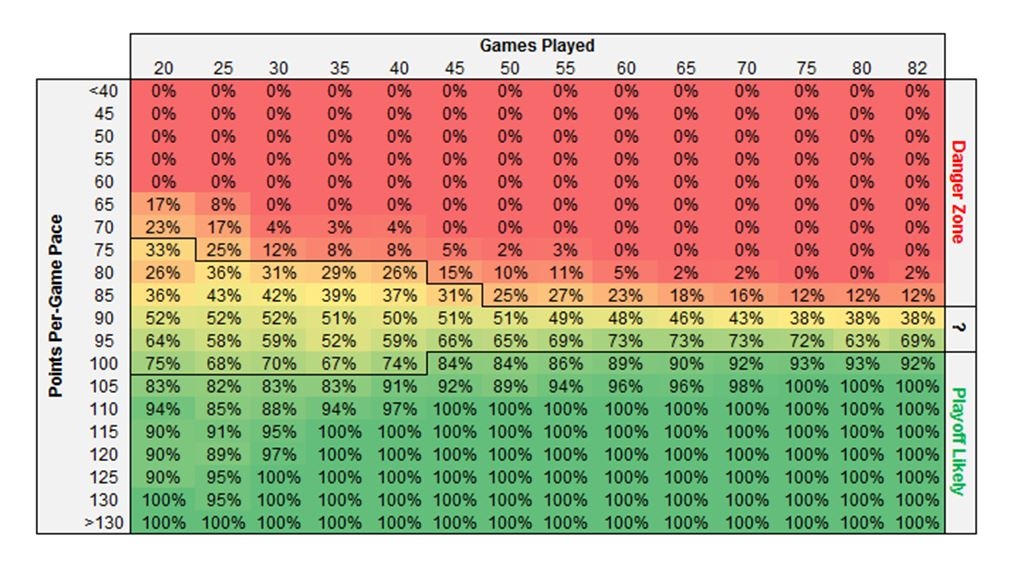Dec 17, 2018
The reality of the NHL playoff race
Most teams believe they’re in a playoff race for the majority of the season, but the data shows we have a very strong handle on a team’s postseason fate by about the 20-game mark, Travis Yost writes.
By Travis Yost

The National Hockey League deserves immense credit for establishing a culture in which most teams (inclusive of front offices, coaching staffs and even their respective fan bases) believe they’re in a playoff race for the majority of the season. The reality is much different.
One of the fascinating parts of the NHL regular season is how tight the standings appear on the surface. Elite and terrible teams become obvious very early, but the middle of the pack always appears to be a muddied mess. Consider the conference races right now. In the East, you have nine teams separated by four wins or fewer. In the West, you have eight teams separated by four wins or fewer. Add in the fact that playoff races are division-based under the latest realignment –finish in the top three of your division, regardless of record, and you’re in – and you further complicate the situation.
But reality is quite different. By now you have probably heard of certain checkpoints or markers that teams reference to legitimize (or delegitimize) their playoff likelihood. Some prefer to look at a team’s position when American Thanksgiving rolls around. Others prefer to wait until Christmas. In many cases, we don’t need that many games to understand a team’s fate as it pertains to the postseason.
Even under the funky division-based playoff system, we have a very strong handle on a team’s fate by about the 20-game mark, and possibly earlier. We don’t need to run complex simulations to understand exact probabilities in varying environments. We can simply use descriptive data since the 2013-14 season to illustrate just how likely (or unlikely) it is for a team to reach a postseason based on their performance through any number of games.
Below is a table that signifies playoff probabilities by points pace and by games played. As you can see, the probabilities are very obvious, but pay particular attention to the tails here. An ugly start isn’t easily overcome. A white-hot start is usually very encouraging as it pertains to a playoff bid. The reason is twofold: points in the bank are highly valuable, and even a simple measure like win/loss record is quite telling about team talent and the ability to sustain winning over the rest of the regular season.
Here’s what the data looks like:

I stratified these into three buckets – teams with a 0 to 25 per cent chance of making the playoffs at any interval, teams with a 25 to 75 per cent chance of making the playoffs at any interval, and teams with a 75 to 100 per cent chance of making the playoffs. What’s interesting to me is that, on a base of only a few years of historical data, the patterns and trends are very predictable.
But consider this under the context of the NHL standings as they sit with Saturday’s games in the books. Effectively every team is within the window of 30 to 35 games played, so we should have a very strong feel of which teams are likely out, which teams are likely in and which teams are on the bubble.

Using our points range and probabilities based on historical data, we can already call six teams (from Ottawa through Los Angeles) as very unlikely to make the playoffs. Another four teams (from Vancouver to Arizona) could join them over the next five or so games as they already sit on the very low end of the bubble. At the other end of the spectrum, at least seven teams (from Tampa Bay to Buffalo) seem like locks to reach the playoffs, and Colorado may be joining them in a matter of days.
The point being: don’t be disoriented by jumbled standings. If you include Colorado, half of our playoff race appears to be reasonably decided. That means 13 teams are competing for the final eight spots. It’s still an incredible race and will be impossible to predict how this segment will evolve over time, but drawing a distinction as to who is really in this playoff race is an important one – especially if you’re a general manager at the bottom of the table and of the belief that your team may be alive.
You will frequently hear or read things like “the team is just a couple of wins back of a playoff spot,” which certainly implies that said team is in a playoff race. Teams might even make aggressive, buy-now decisions to chase those two wins. But the reality is that the team isn’t just two wins out of a playoff spot. There are 30 other teams in the NHL, playing each other every day with a minimum of two points guaranteed to be allocated every time the final whistle sounds.
So what feels like an easy deficit to erase is actually quite difficult, because the teams that are ahead will continue to grab points in the standings by virtue of the schedule.

